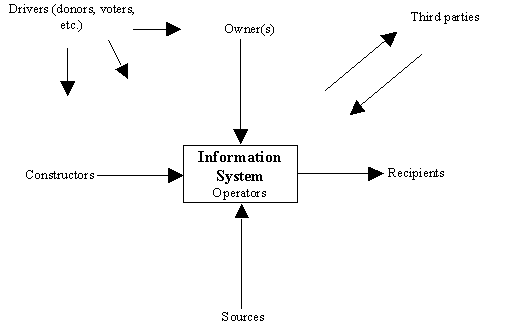In the Techniques section:
Techniques
eTransparency Project Stakeholders
Who is involved in my e-transparency project?
Stakeholders are all those who may have an important impact on your project, or on whom your project may have an important impact. For a simple project, the stakeholders may seem obvious, but in many e-transparency projects you run the risk of forgetting a significant individual or group. If you forget them, you may mis-design the e-transparency application, or miss out important costs or benefits, or find you are being undermined by a group who feels "left out in the cold".
Stakeholder Mapping
Stakeholder mapping is a simple technique to make sure you haven't forgotten anyone important in planning, designing, implementing or evaluating your project. Simply run through the seven categories outlined below - summarised by the acronym DOCTORS (Drivers, Owners, Constructors, Third parties, Operators, Recipients, Sources) - and map out the key groups and individuals that belong to the category for your project.

- Drivers: those who are pushing the project forward; often they will be from outside the implementing agency, and they may well be providing key funding for the project. Follow this link for more details on e-transparency project drivers.
- Owners: the manager of the organisation or department that owns and uses the system, who is ultimately responsible for the system. That manager, in turn, may have their own line manager who may be seen as a secondary owner. The 'tree' of owners could rise as far as a Permanent Secretary or Minister, even up to Prime Minister/President for a large, high-profile e-transparency project.
- Constructors: those who analyse, design and build the e-transparency system including the builders/suppliers of the hardware, software and networks.
- Third parties: others who could have an important influence on the project or on whom the project will have an important effect.
- Operators: those who carry out the activities that make the e-transparency system work; not just clerical staff, but may also be managers and technical maintenance staff.
- Recipients: those to whom data or services are delivered by the e-transparency. Sometimes you can divide these into primary recipients, who get the data/services directly; and secondary recipients, who only get the data/services indirectly via the primary recipient.
- Sources: those who provide data for the e-transparency system; often public servants but not always.
NOTE: these roles do overlap, so stakeholders may appear under more than one category, such as drivers who are also recipients, or operators who are also sources.
Worked Example
Stakeholder analysis will be undertaken for the VOICE project, a multi-channel initiative in Vijayawada Municipality, India, to disseminate information about government activities to citizens, and to enable online services interactions (follow this link for more detail on the VOICE case study).
- Drivers: VOICE was driven on by two external groups. First, the very dissatisified citizens in Vijayawada who provided both the political (as voters) and financial (as taxpayers) underpinning for Vijayawada Municipal Corporation (VMC). Second, the World Bank which provided funding support for the project, but which sought to use the funding to leverage good governance gains in India.
- Owners: the head of VMC was the immediate owner of the project, though one could also see the Chief Minister of Andhra Pradesh state (in which VMC was located) as a more distant ultimate owner.
- Constructors: this information system was created by a large local IT firm, CMC Ltd.
- Third parties: middlemen had previously been operating in Vijayawada, charging citizens or businesses money in order to access government data or services.
- Operators: the technical part of the system was operated by a group of staff from the IT department of VMC with help from some CMC plus the cable TV channel staff and kiosk operators. Managers and clerical staff within VMC were responsible for operating the data/service and broader procedural elements of the VOICE system.
- Recipients: the system delivers data and transactional services to the citizens and businesses of Vijayawada. In some situations, a community-based organisation or NGO may access services online on behalf of a group of poor citizens. In that case, the community-based organisation/NGO is the primary recipient; the poor citizens would be secondary recipients.
- Sources: data and processes are provided for VOICE by a range of public servants within VMC.
This comprehensive stakeholder map would provide the basis for an effective approach to planning and design of the e-transparency system. Equally, it could be used post hoc for a thorough evaluation of the system. In both cases, it would guide you about who to talk to, and about whose views to take into account.
Stakeholder Questions
In analysing the stakeholders it is useful to ask the following questions. This will give you a better insight into the chances of success or risks of failure for your e-transparency project:
- To what extent are the roles present? If there is no project driver, for instance, your e-transparency project is unlikely to succeed.
- To what extent is there overlap between the roles? If, for example, the owner and driver are the same person, this bodes well for the project.
- If roles are separated, to what extent is there conflict or cooperation between the different stakeholders? When there is conflict, the project may not succeed.
- From among all the stakeholders, who are the opinion leaders: those whom others will watch to see if they accept the new e-transparency system and the changes it may bring? Within the opinion leaders particularly, but within all stakeholder groups generally, what is the balance between:
- resistors: those with a vested interest in the existing system, or those who have a general dislike of change, and
- adopters: those with a vested interest in the new system, or those with are quick to pick up new methods and techniques?